Vasily Pavlovich Mishin – missiles, space and education
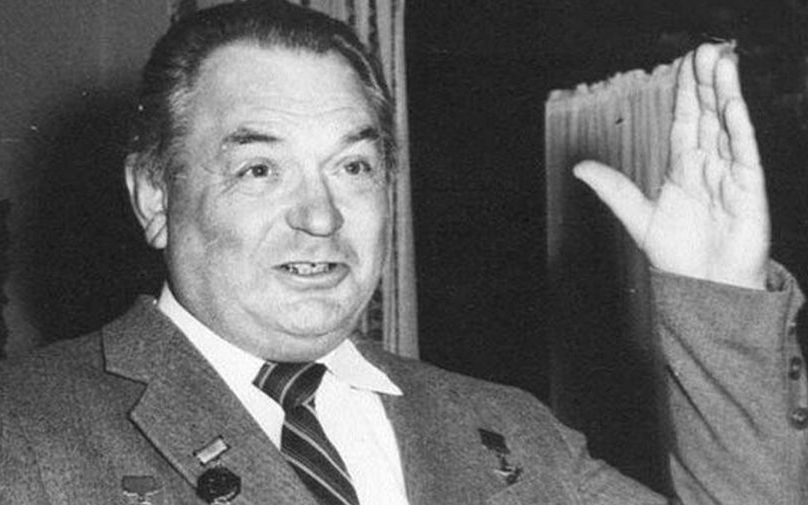
January 8, 2022 marks the 105th anniversary of the birth of the outstanding graduate of Moscow Aviation Institute – the famous designer of rocket and space equipment, one of the founders of Soviet cosmonautics, Vasily Pavlovich Mishin.
Vasily Pavlovich Mishin is a member of the Academy of Sciences of the USSR and the Russian Academy of Sciences, professor, Hero of Socialist Labor, laureate of the Lenin and State Prizes, winner of the first gold medal named after S.P. Korolev. He was Sergey Pavlovich Korolev’s closest friend and comrade and it was he who continued his works for cosmonautics.
This article is about his professional path and his most important works, including his educational activity at Moscow Aviation Institute.
Founders of rocket technology and cosmonautics
Serious research and developments in rocket and space technology in the USSR began during the first post-war years and were aimed at the quickest creation of domestic ballistic missiles, as the most important component of the country's nuclear missile shield, in fierce competition with the United States. Subsequently, these works naturally began to be embodied in the creation of rocket and space technology and also competed with those carried out in the United States during the same period of time.
The highest level of secrecy of the projects led to the classification of scientists and experts. The media did not mention the names of the leaders of such projects. It was only known that fundamental scientific work was headed by some "chief theorist of cosmonautics", and this was the president of the USSR Academy of Sciences (AN USSR), Academician Mstislav Vsevolodovich Keldysh; applied research and design work led by the "chief designer", and it was really the chief designer, head of OKB-1 Sergey Pavlovich Korolev. Sergey Pavlovich Korolev used the nickname K. Sergeev for public speaking. Similarly, Korolev's deputy, Vasily Pavlovich Mishin, could only be published under the nickname M. Vasiliev.
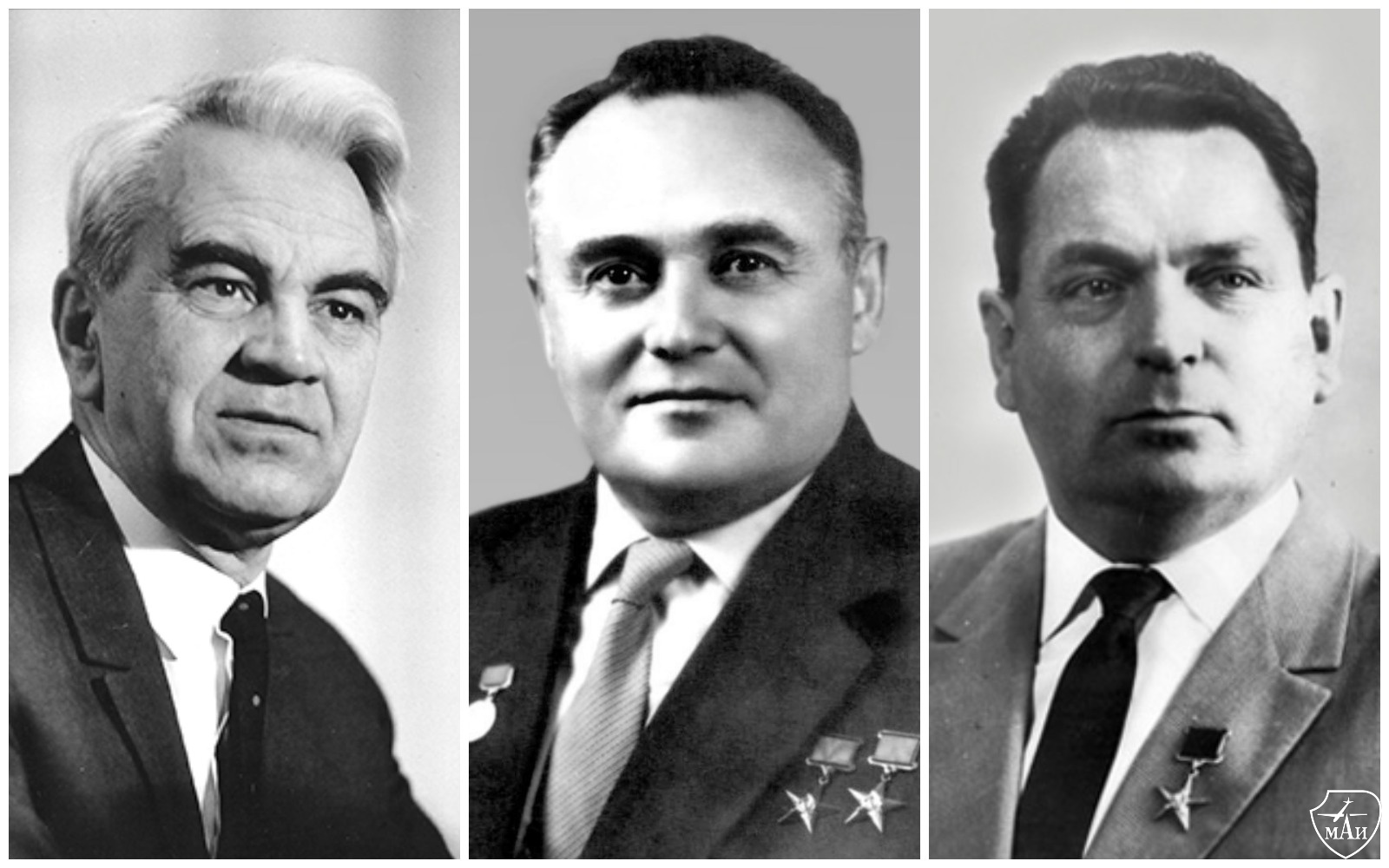 M.V. Keldysh, S.P.
Korolev, V.P. Mishin
M.V. Keldysh, S.P.
Korolev, V.P. Mishin
Only after quite a long period of time and after the comparison with the current times, we begin to understand and evaluate the huge contribution to the formation and development of domestic rocket and space technology, made by the pioneers: Sergey Pavlovich Korolev, Vasily Pavlovich Mishin, Vladimir Pavlovich Barmin, Valentin Petrovich Glushko, Nikolay Alekseevich Pilyugin, Alexey Fedorovich Bogomolov, Mikhail Sergeevich Ryazansky, Vasily Ivanovich Kuznetsov, Vladimir Nikolayevich Chelomey, Mikhail Kuzmich Yangel, Viktor Petrovich Makeev, Alexander Davidovich Nadiradze and other key figures, outstanding founders of the rocket science. In this brilliant galaxy of talented and hard-working designers and scientists, Academician Mishin, Korolev's right hand, played very important role. He was, like Korolev, selflessly devoted to the Motherland, space exploration and ensuring the defense capability of our country.
First steps to start a long path
In the 30s of the last century aviation, gliding and parachuting were very attractive for young people. In 1930, Moscow Aviation Institute (MAI) was founded, and many wanted to study there. Vasily Mishin also dreamt of it.
In 1931, at the age of 15, he graduated from the school, where he studied for seven years, and became a fitter's apprentice at the so-called Factory Apprenticeship School (FZU) at the Central Aerohydrodynamic Institute (TsAGI). After the FZU, he was sent as a mechanic to the TsAGI special assignments workshop, where he worked till September 1935. At the same time, without interrupting his work at the production, he studied at the evening training courses at a technical college. In September 1935 he was sent to study at Moscow Aviation Institute to become a mechanical engineer for aircraft weapon. He graduated from Moscow Aviation Institute in April 1941.
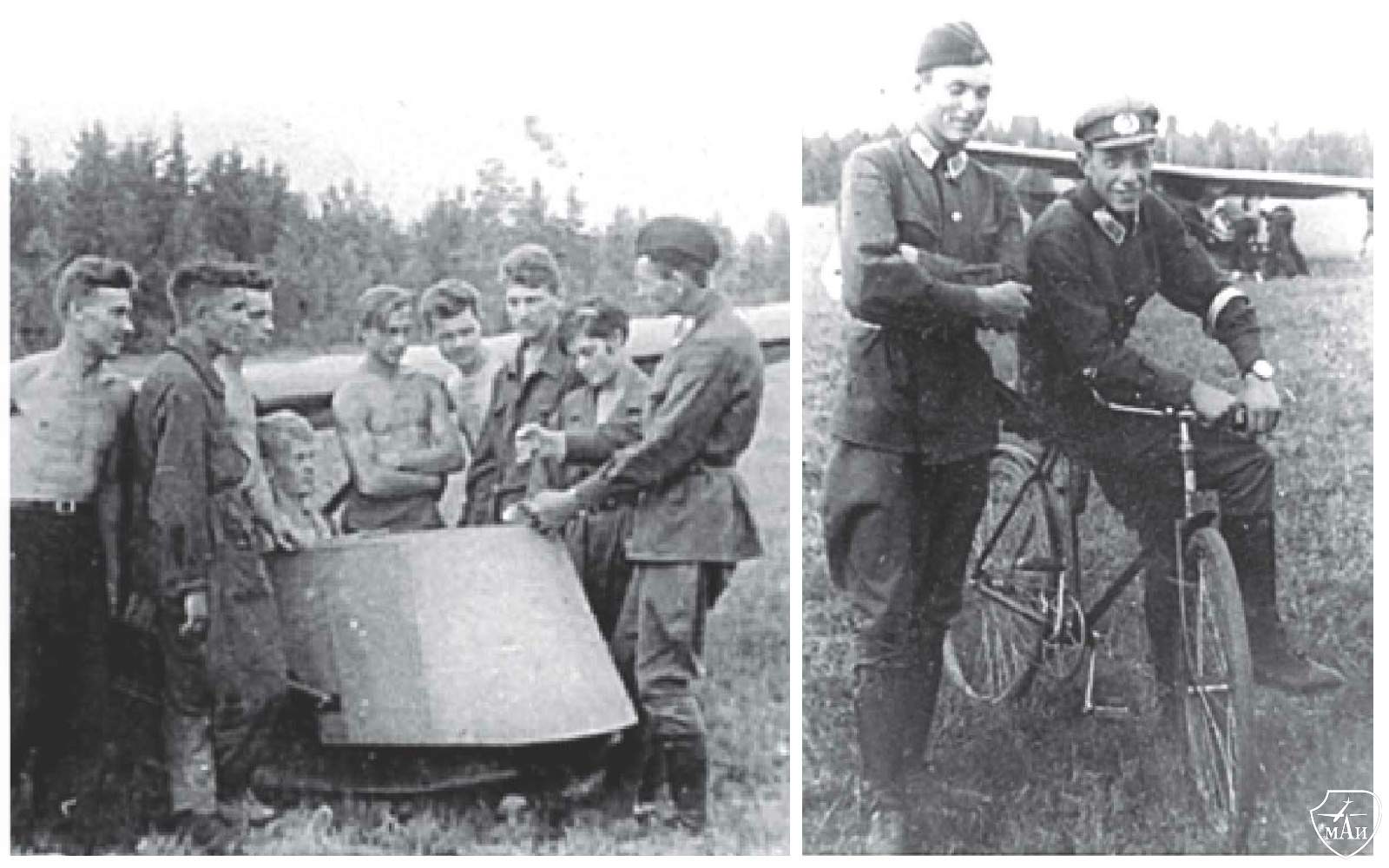 V.P. Mishin giving
the pre-flight briefing at the airfield of the flight school
V.P. Mishin giving
the pre-flight briefing at the airfield of the flight school
While still being a student of Moscow Aviation Institute, Vasily Mishin, from undergraduate practice, began to work as the designer at the Design Bureau of Plant No.293 of the People's Commissariat of the Aviation Industry, headed by Viktor Fyodorovich Bolkhovitinov. Here, during the war years, he took part in the creation of aircraft weapons systems, including the first Bi-1 rocket fighter.
Mishin was awarded with the Red Star in 1945 for successful technical solutions. It was this first award that Vasily Pavlovich valued the most.
In 1944 he was included in the group of experts who studied the so-called "fragments" of the V-2, and after the work of this group was over, he received his personal assignment from V.F. Bolkhovitinov, it dealt with theoretical issues of high-altitude and long-range missiles.
In August 1945, he worked in the Interdepartmental Commission of the Central Committee of the All-Union Communist Party of Bolsheviks for the study of German rocketry. He was sent to Germany and Czechoslovakia as the head of a group of specialists, whose task was to find the V-2 technical documentation. Then a bureau was created under the leadership of Mishin on the problems of aerodynamics, ballistics, strength and other issues related to the V-2.
And, finally, after the historic meeting in Germany with Sergey Pavlovich Korolev (1945) he received the offer to work under his leadership (1946). It was then that they became close associates in the creation of the first domestic ballistic missiles, launch vehicles and spacecraft.
How great deeds began
In May 1945, by a decree of the Council of Ministers of the USSR on the deployment of work on rocket weapons in the country, an institute was formed at NII-88 (TsNIIMash) with the rocket technology department (head of department – S.P. Korolev, deputy – V.P. Mishin). On its basis, in 1950, the Special Design Bureau – OKB-1 (later TsKBEM, NPO Energia, RSC Energia) was created, the chief designer and director of which was S.P. Korolev, the first deputy – V.P. Mishin.
Sergey Pavlovich entrusted Mishin with major and perhaps the most creative area of work in OKB-1 - science and design activities, with which he successfully coped. He was the generator, as they would say now, of innovative ideas. And then the ideas were searched for desperately, since almost everything was created from scratch. The scale of the created nuclear missile shield and the breakthrough into space, the greatness of scientific and technological achievements and the shortest possible time for their implementation – there is no way we can overestimate all that now.
At first, almost immediately after the end of the Great Patriotic War, it was necessary to master and introduce the latest sophisticated rocket technology, and there were very few experts in our country who were able to do that.
The situation in the USA was absolutely different. Shortly before the end of World War II, the secret missile center in Peenemunde (Germany) and the rocket assembly plant in Nordhausen, designed to assemble up to 1,000 V-2 rockets per month, were in the zone that was occupied by the American troops. They captured not only hundreds of rocket experts, but also took all the documentation (more than 14 tons!) to America with them. And a hundred of ready-made V-2 rockets also. When our army entered this zone, there was little left.
Here is what Vasily Pavlovich Mishin writes in his memoirs: “Before leaving Nordhausen, the Americans did everything possible to ensure that minimum minimorum of the information about German missile technology would be given to the Russians. They took to the USA many key science experts led by Wernher von Braun and General Walter Dornberger, about 100 fully assembled V-2 missiles and blew up the assembly plant. This was one of the harbingers of the Cold War. The group working in the Nordhausen area had to assemble individual units, instruments and technical documentation with great difficulty. Enterprises that manufactured units, engine fittings, radio control system devices, ground equipment units for V-2 and other German missiles were scattered throughout Czechoslovakia, Austria, Hungary, and Poland. The Prague group, which included me, managed to find a German military archive, which was sent through Czechoslovakia from Torgau (Germany) to be buried in one of the lakes in Austria. In this archive, the incomplete set of technical documentation for V-2 missiles was found without general views, diagrams, calculations and descriptions. These drawings were sent to Moscow in early November 1945." (From the book by V.P. Mishin “Notes of a rocket scientist. Memoirs, diaries, interviews”, 2017).
Therefore, shortly after the end of the war, flight tests of these missiles were launched in the United States, and German experts got involved in American weapon and later space projects.
In our country, we had to start work in this area, if not from scratch, but in much more complicated and uncertain conditions.
In September 1946, Mishin came back to the USSR, and was transferred to Kaliningrad, the future city of Korolev, and became the first deputy chief designer of Sergey Pavlovich Korolev in OKB-1. At this point, Vasily Pavlovich Mishin was not even 30 years old.
At the end of the 40s of the last century, the USSR was close to ending work on the creation of a nuclear bomb; it was necessary to create rocket delivery vehicles. Then a kind of triumvirate of academicians was formed of Igor Vasilyevich Kurchatov, scientific director of the work on creating the atomic bomb, Sergey Pavlovich Korolev, chief designer of OKB-1, and Mstislav Vsevolodovich Keldysh, president of the USSR Academy of Sciences, director of the Institute of Applied Mathematics of the USSR Academy of Sciences.
There is a famous picture that was not shown the way it was in reality for a long time - only the fragment with the three great scientists (the three "K"). In fact, the photographer in 1959 captured four people: the fourth was Vasily Pavlovich Mishin, who also took active part in this creative union.
 S.P.
Korolev, I.V. Kurchatov, M.V. Keldysh, V.P. Mishin (August 1959)
S.P.
Korolev, I.V. Kurchatov, M.V. Keldysh, V.P. Mishin (August 1959)
By the way, in the same year, the first interplanetary program in the Soviet Union was adopted by the Decree of the Government of the USSR.
It is worth mentioning that in the late 1950s the government was more optimistic than in the late 1940s. A kind of parity was established between the USSR and the USA in the possibilities of delivering nuclear charges by long-range ballistic missiles, and the first space breakthroughs took place. Of course, we must pay tribute to the pioneers of rocket and space technology. First of all, to Korolev, the brilliant strategist and great organizer. But he was not alone: without his colleagues, without Mishin, these achievements, as well as the ones that followed, especially in the shortest possible time, would hardly be possible ever.
Ballistic missiles
It was Mishin who headed large complex of scientific research and design developments for the creation of ballistic missiles, starting with the first missile, the R-1, which had a flight range of 270 km. Its first launch took place in 1948. Next was the creation of the R-2 rocket with the range of 590 km.
In 1953, the operational-tactical missile R-11 was developed for mobile land and sea basing with the flight range of 270 km (put into service in 1955). It worked on high-boiling fuel components, which made it possible to store and transport the refueled missile.
The first Soviet strategic missile R-5 with a range of up to 1200 km and a detachable warhead was created in 1953, and in 1955 the R-11 FM missile appeared, based on a submarine, carrying a nuclear charge. It marked the beginning of the marine branch of the development of Soviet missile technology.
The R-5M missile with a nuclear charge was tested in 1956. Mishin was awarded the title of Hero of Socialist Labor for the creation of the R-5 rocket in 1956.
1957 was marked by brilliant achievement - the R-7 intercontinental ballistic missile was created, it was built according to the two-stage scheme (with the launch weight of 280 tons). At that time, the appearance of such weapon played crucial role for the defense of the country.
In 1961, a fundamentally new intercontinental two-stage liquid-propellant R-9, ground-based and silo-based missile, was developed with a noticeably greater range than R-7, and with much better operational properties, smaller weight and dimensions. It was in this project, under the leadership and direct personal participation of Mishin, that the revolutionary cryogenic technology was developed and implemented successfully - the technology of using supercooled liquid oxygen with a high-speed refueling time of R-9 of only 5–6 minutes.
Vasily Mishin's contribution to the creation of all these missiles in those severe times with utmost harsh deadlines can hardly be overestimated.
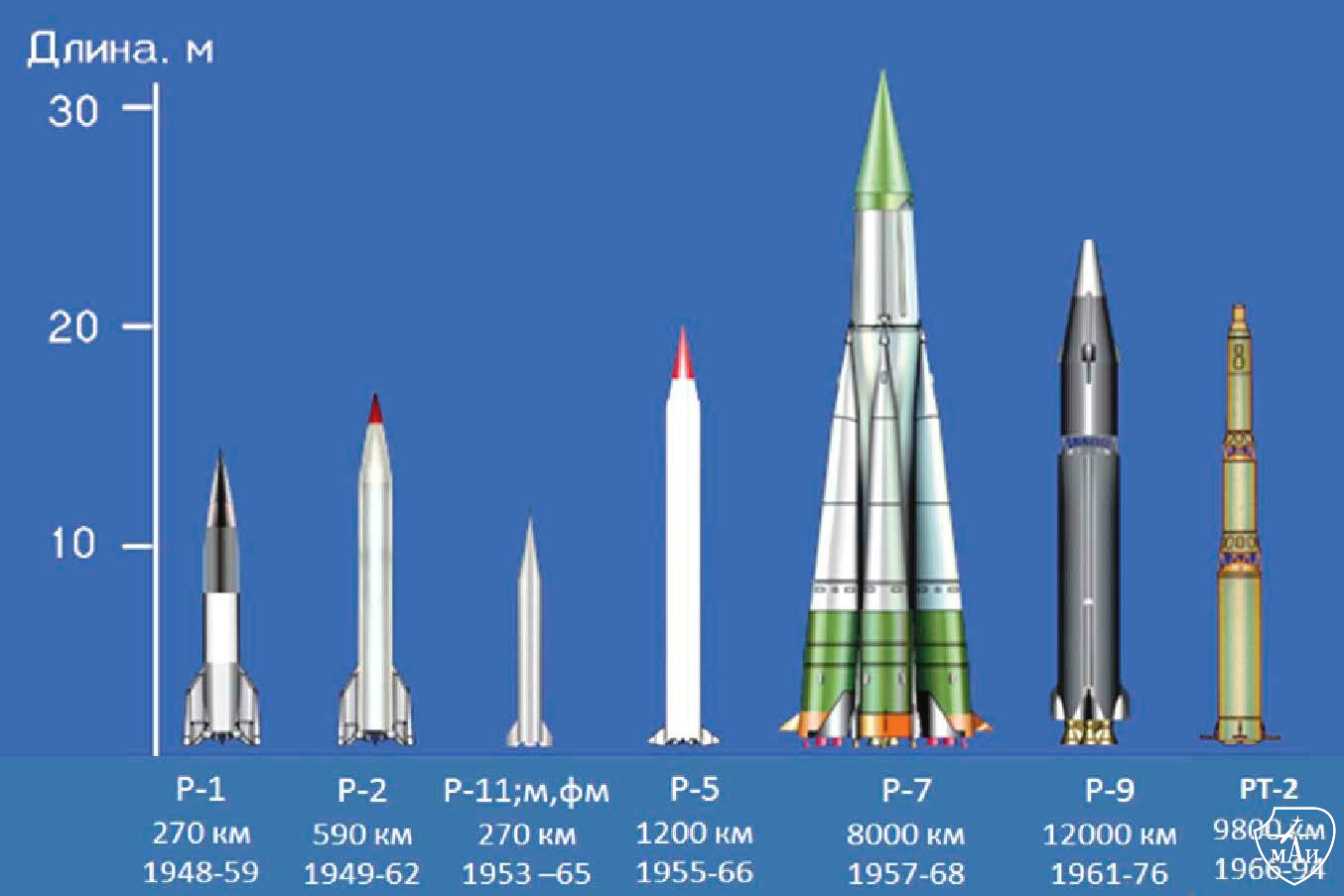 Ballistic
missiles
Ballistic
missiles
Spacecraft launch vehicles
In addition to the defense theme, since 1957 OKB-1 has been actively involved in rocket and space transport systems.
1957-1958 – Sputnik launch vehicle – ISZ-1, ISZ-2, ISZ-3;
1958-1991 – LV "Vostok" – automatic station "Luna" and manned spacecraft;
since 1960 – LV "Lightning" – communications, exploration of the Moon, Mars, Venus;
1963-1976 – Voskhod launch vehicle – manned spacecraft and Zenit spacecraft;
since 1966 – LV "Soyuz", "Zond" – manned and cargo vehicle, exploration of the Moon;
1969-1974 – N1-LZ rocket and space system – lunar program.
The launch of the first artificial satellite (AES) on October 4, 1957 using a launch vehicle (RN) R-7, which for space purposes was named Sputnik, made a real sensation in the world. The launches of the second and third satellites followed soon.
The R-7 served as the basic design for the creation of the three-stage Vostok launch vehicle, which made possible the launch of heavy satellites, the first flights of automatic vehicles to the Moon, and, most importantly, manned space flights.
The legendary first space flight of a man – Yury Gagarin – was on April 12, 1961. This was the event of greatest importance not only for the USSR, but for all mankind.
The next modification of the R-7 was the four-stage Molniya launch vehicle. It made it possible to carry out interplanetary flights of robots to Mars and Venus, to increase the mass of spacecraft for flights to the Moon (including soft landing on the lunar surface) and put into orbit satellites of the Molniya series in order to establish radio and television communications with the Far East and Siberia.
On the basis of the Vostok carrier, a three-stage Voskhod launch vehicle was developed to launch multi-seat ships, and then the Soyuz launch vehicle.
As a result, the weight of spacecraft launched into near-Earth orbit was increased to 7.3 tons, manned space flights with two and three cosmonauts were completed, cosmonauts went to outer space, and Soyuz spacecraft docked in orbit.
The improved Soyuz rocket and space complex was used in such programs as Salyut, Soyuz, Soyuz – Apollo, Salyut-6 – Soyuz – Progress, Mir and the ISS. In 1973, another Soyuz-U space rocket from the famous R-7 series flew successfully. This is how they used to create long ago!
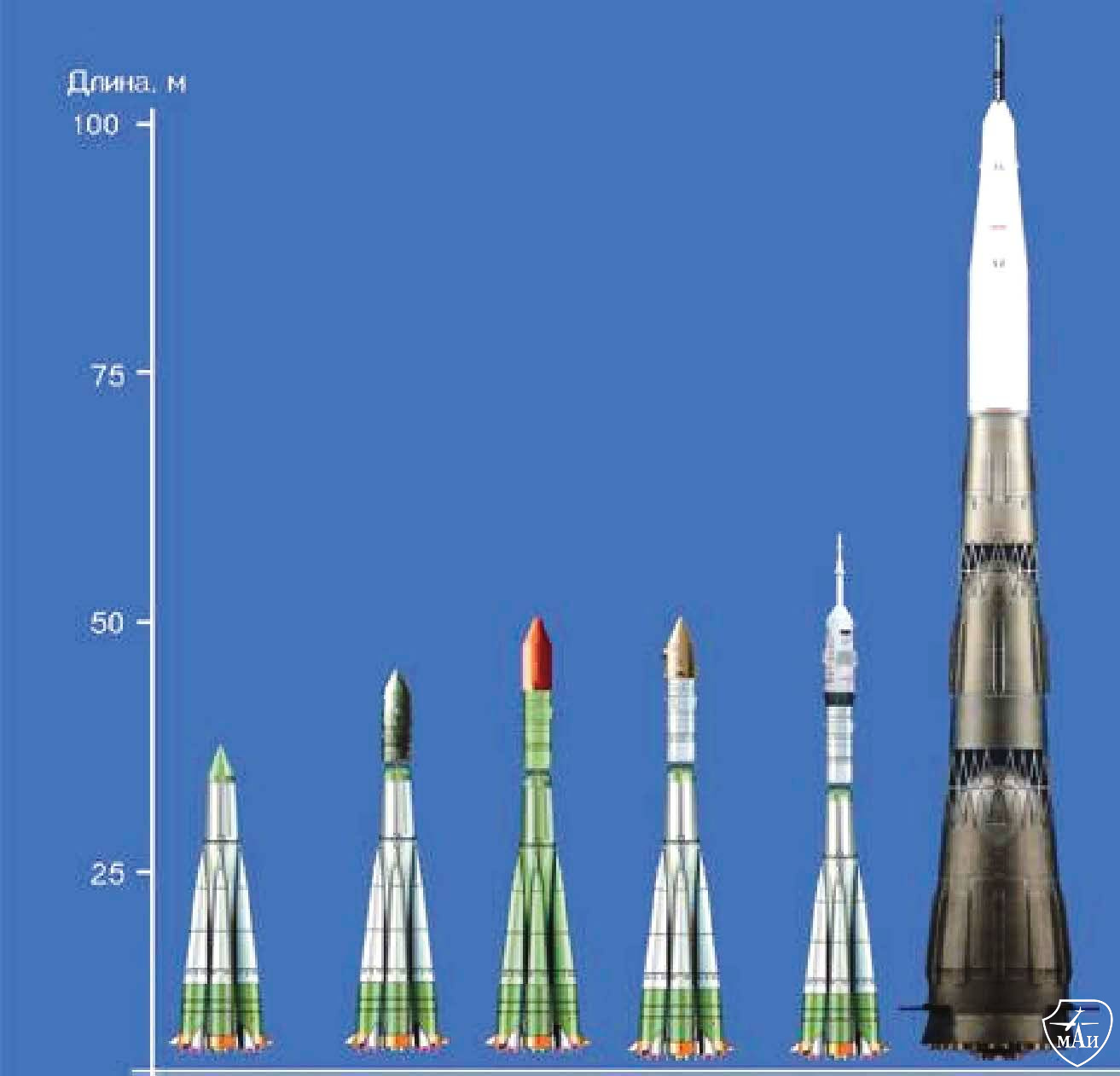 Spacecraft
launch vehicles
Spacecraft
launch vehicles
It should also be noted that several versions and modifications of the Soyuz launch vehicle are still the main Russian medium-sized carriers and it is the only rocket today that delivers crews to the International Space Station on the regular basis.
The N-1 launch vehicle and the manned lunar complex were also of particular importance and complexity, in every sense. Mishin’s name is often associated directly with the “Tsar Rocket” – the N-1, that was designed to solve a number of priority tasks in space and ultimately ended up on the critical path of the Soviet manned lunar expedition. After four failed launches, the Soviet manned lunar program was closed in 1974 (despite the fact that the flight test program included testing of two more rockets that were practically assembled already). The history of the Soviet lunar program over the past decades was reflected in a number of historical publications.
Academician Mishin was the author of a number of technical solutions in rocket science, which were distinguished not only by courage and originality, but also by special rationality. Many of them are still included in the main fund of design solutions. For the R-7, this is a horizontal assembly in a mounting housing instead of a more expensive vertical one; suspension for power units on the side boosters at the points of their attachment to the central block, as a result of it was lighter; abandonment of gas-jet rudders and transition to control with the help of control engines. At that time, these were fundamentally new, and even revolutionary, technical solutions.
Korolev's successor
In January 1966, the unexpected happened – the diagnosis, which led to a fairly simple medical operation, turned out to be a mistake, and Sergey Pavlovich Korolev died literally under the knife. This was not only the tragedy for people close to him, fellow workers, but also the irreparable loss for the whole country. The union of Korolev and Mishin broke up.
After the death of the chief designer Academician Korolev in 1966, Mishin was appointed head and chief designer of OKB-1, which was soon renamed TsKBEM (future RSC Energia). But Mishin's work became a hundred times more difficult – he was not any longer together with such an outstanding person, scientist, organizer and his friend, Sergey Pavlovich.
As an exceptionally reliable person who truly appreciated friendship, Mishin was always devoted to Korolev. He took care of him when they lived together at the Baikonur Cosmodrome, supported him in almost all his endeavors. It was hard for him to go through the unexpected loss of a person dear to him. And the first thing that the deputy and friend of Sergey Pavlovich did after the news of his death was to take an unprecedented step at that time, insisting on declassifying the name of the chief designer of rocket and space systems. And then, till his death, he closely followed the truthful reflection of the role of Korolev in cosmonautics, defended this role and the achievements of OKB-1 in rocket and space technology.
Respect and dedication to Korolev during the process of joint work does not mean that Mishin always followed the opinion of Sergey Pavlovich at all. The bright example is the development of the famous R-7, the "seven". Before creating an intercontinental missile, Korolev’s task was to make the R-3 missile at a range of 3000 km. And this work in the Design Bureau went energetically. However, Vasily Pavlovich had a different opinion - he considered it right to immediately create a rocket at a range of about 10,000 km. It was this proposal, based on the research work carried at the Design Bureau, that was submitted for consideration.
Despite a number of objections from several chief designers, Mishin managed to prove not only the possibility, but also the necessity of such solution. Work on the R-3, which was going on for almost two years, was curtailed, and the design bureau switched to the R-7 intercontinental missile. Mishin was responsible for the development of the structural layout and the choice of the main design parameters. As it turned out later, the decision taken by him was the only correct from the point of view of the fastest possible military-political nuclear-missile parity with the United States. Created in 1957, the "seven" was also destined for a long peaceful work, which began with the launch of the first satellite, which opened the space age for mankind.
Vasily Pavlovich was familiar with the first group of cosmonauts, including Yury Alekseevich Gagarin. He believed, in contrast to Korolev, whose choice fell firmly on Gagarin, that German Stepanovich Titov should have been chosen to become the first cosmonaut. But some time later after Yury Gagarin's fantastic space flight and stunning worldwide fame, which did not affect his character, simplicity and natural behavior when communicating with different people – from a worker to the empowered of this world, on his amazing smile, Vasily Pavlovich admitted that Korolev was absolutely right in his choice. At the same time, Mishin retained his respect and affection for German Stepanovich as a wonderful person and cosmonaut.
And the work went on
It is impossible to tell in details about all the Mishin’s projects in one article. Let's list just a few of them: 1959 - launches of interplanetary stations "Luna-1-3"; 1961 – launch of the automatic interplanetary station "Venera-1"; 1961 – the first launch of the R-9 intercontinental ballistic missile, which is extremely important for the defense of the USSR; 1962 – the creation of a space automatic reconnaissance satellite "Zenith"; 1965 — launch of the first communications satellite Molniya-1 into orbit; 1966 – the beginning of flight tests of the first Soviet serial solid-propellant intercontinental ballistic missile RT-2.
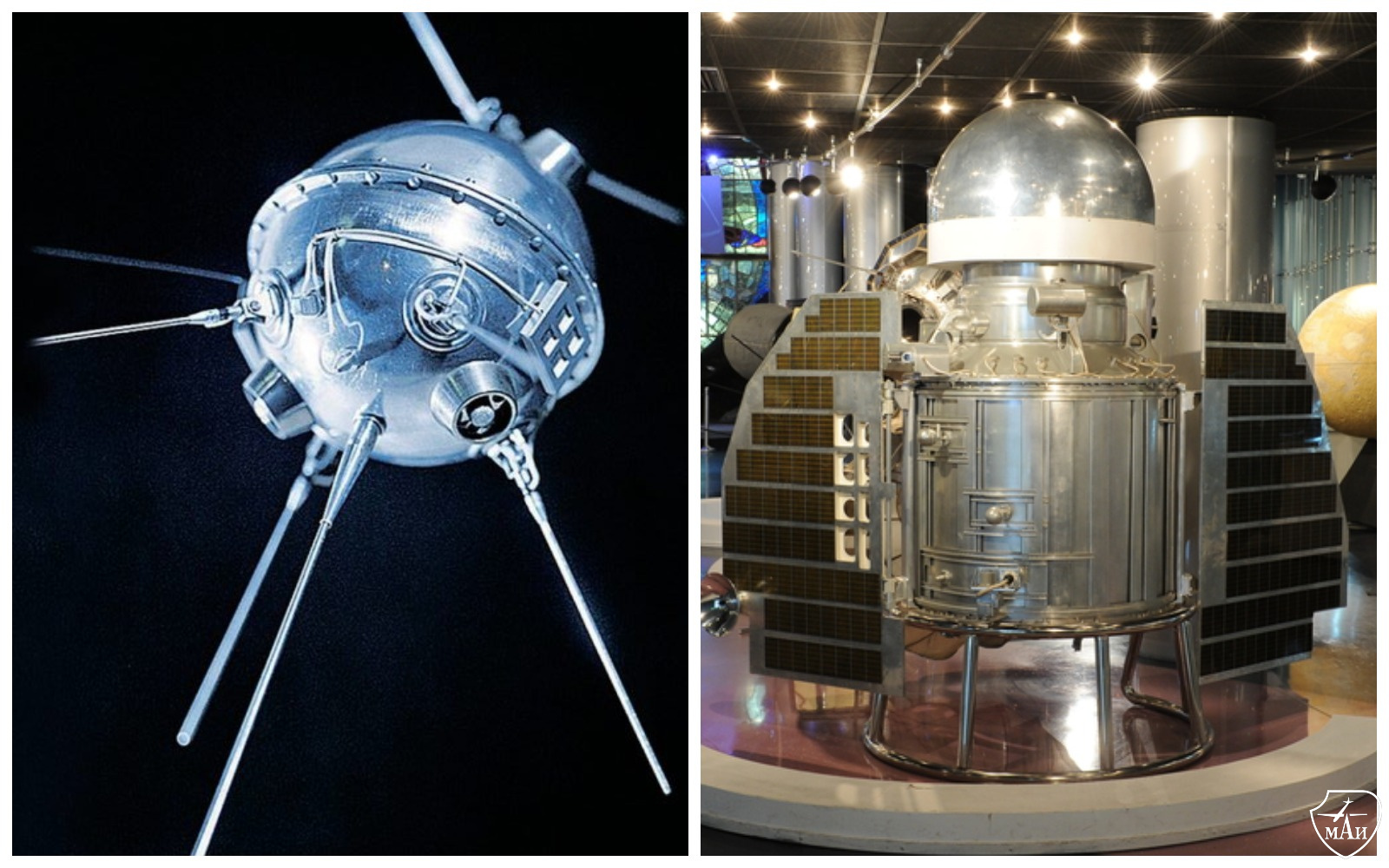 "Luna-1"
and "Venus-1"
"Luna-1"
and "Venus-1"
Manned spacecraft
After the death of Korolev, Academician Mishin headed the Korolev Design Bureau and, accordingly, the manned space program. Despite all the difficulties of working in the new conditions, this period was also marked by unique tasks and solutions.
Under the leadership and with the participation of Vasily Pavlovich, the Soyuz spacecraft was developed and implemented, and the development of the Progress unmanned spacecraft was started on its basis.
In 1968 – flyby of the Moon and return to Earth of the manned spacecraft "Zond" in automatic mode.
The Salyut orbital station, the first in the country, was created and launched into orbit.
For two years until 1974, a program of joint manned flight of the Soviet Soyuz spacecraft and the American Apollo spacecraft was prepared successfully. The program was implemented a year after Vasily Pavlovich stopped working in the "royal" design bureau.
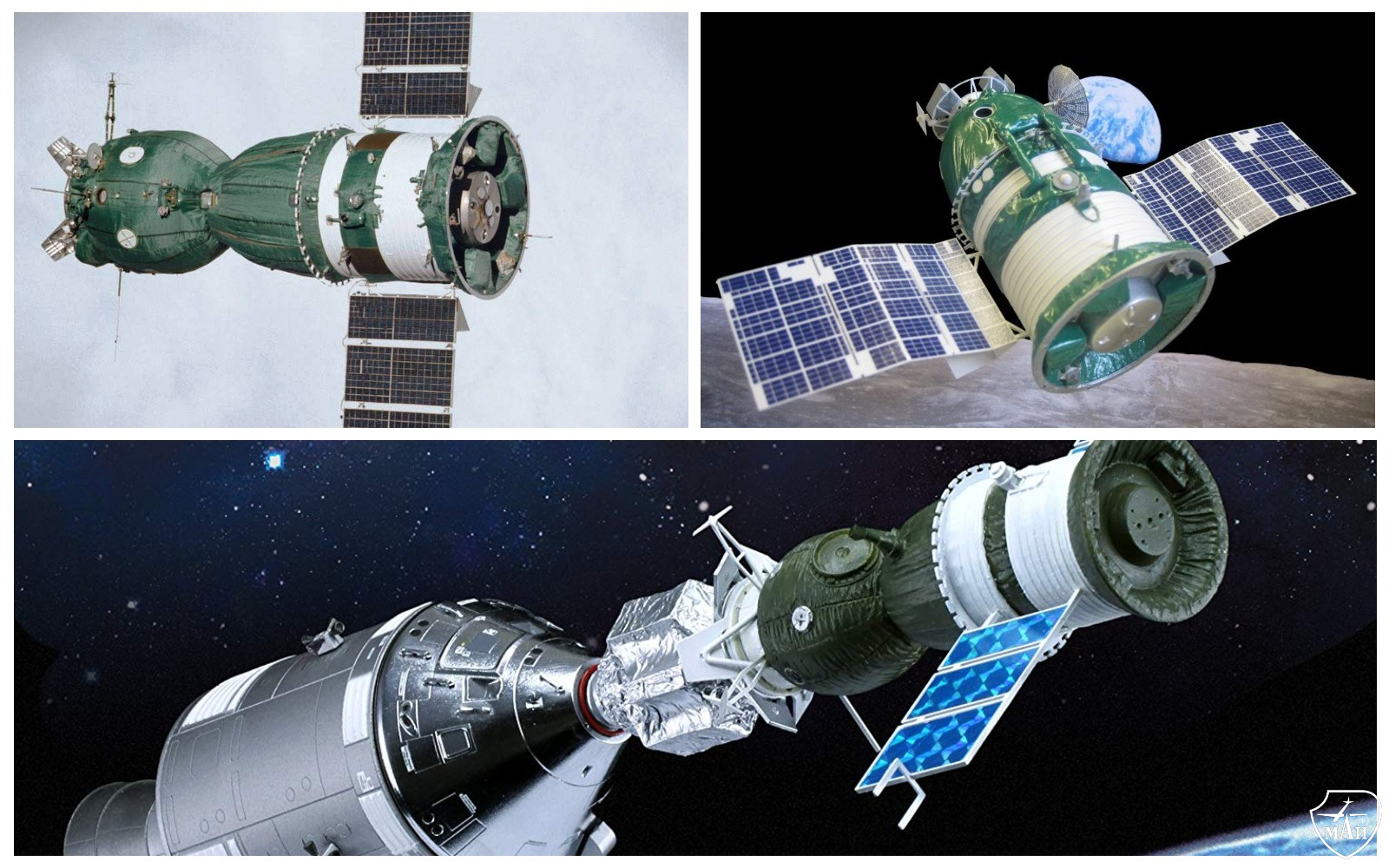 Soyuz,
Zond and Soyuz-Apollo docking
Soyuz,
Zond and Soyuz-Apollo docking
As part of the N1-LZ lunar program, a very reliable unified upper stage "D" with non-toxic fuel components was created, which was then used to launch interplanetary stations of "Venus" and "Vega" series, geostationary satellites "Rainbow", "Horizon", "Ekran" and etc.
Manned lunar complex was developed, consisting of a lunar orbital (LOK) and a lunar landing (LK) spacecraft.
The last test of unmanned version of the N-1 launch vehicle with standard LOK and LK, was on November 23, 1972. A few seconds before the estimated time of separation of the first and second stages due to hydraulic shock, the rocket exploded at the 107th second of flight.
Further tests of the N-1 launch vehicles were not carried out, although the designers hoped that the launches scheduled for 1974 would be successful. The next two rockets were already ready for the launch. In August 1974, the fifth launch was to take place, and at the end of the year, the sixth and, as the designers believed, the last one before the successful commissioning of the N-1 launch vehicle.
But in May 1974, the Soviet lunar program was closed, and all work on the N-1 was over. Two ready-to-launch N-1 were destroyed.
Chief designer and fundamental science
Academician Mishin took active part in solving many other topical scientific and technical problems in rocket and space technology. In particular, this applies to the issues of application and long-term, practically unlimited storage of cryogenic environmentally friendly fuel components. In particular, such technologies were developed in relation to the operation of the R-9 intercontinental ballistic missile. Closed systems have been created to provide temperatures at the boiling point of liquid helium using solar energy.
Vasily Pavlovich had a unique ability to predict the development trends of rocket and space technology, to identify topical areas of scientific and practical applications of cosmonautics, to find and involve leading scientific organizations and leading scientists into work.
Thus, close cooperation with Academician Boris Evgenievich Paton and his collaborators made it possible to solve a number of important issues for the creation of large-sized objects in space, quick-detachable structures with their assembly in orbit, the use of special methods of automatic welding in space conditions when performing assembly and repair work. For this, the special "Volcano" installation was invented for automated arc, plasma and electron beam welding.
Cooperation with Academicians Viktor Amazaspovich Ambartsumyan and Grigor Aramovich Gurzadyan led to the creation of the first space telescope on board the Soyuz spacecraft and the ORION-1 and ORION-2 observatories at the first Salyut orbital station in 1971 and the Soyuz-13 spacecraft in 1973.
Collaboration with Academician Nikolay Nikolaevich Sheremetevsky led to the development of a cost-free system for gravitational stabilization of the orbital station in combination with the use of gyrodines.
Mishin's merit is great in the formation of one of the leading enterprises in rocket engine building in Voronezh and the involvement of Nikolay Dmitrievich Kuznetsov and his Samara enterprise in the creation of liquid rocket engines.
Vasily Pavlovich had the ability to see the true problems of the development of rocket and space technology, predict important moments and stages in the development of Soviet-Russian cosmonautics, identify topical areas of scientific and practical applications of rocket science, find talents and involve them in work. Vasily Pavlovich had amazing intuition. He could predict the fate of a new project. And so it happened with the famous "Buran". And he spoke about the “Sea Launch” space launch complex with great doubt.
Contribution into science and education
Since 1974, a new stage started – the work at Moscow Aviation Institute as head of department 102 (now - 601) "Design and construction of aircraft" (since 1987 - "Space systems and rocket science"). Vasily Pavlovich was one of the founders of the department in 1959 and headed it for 31 years from the date of foundation (until 1974 he headed the department part-time). A very strong scientific and pedagogical team has developed here. The department always was tied with industry closely. Vasily Pavlovich laid the foundations for the basic course of lectures on the design of launch vehicles, space transport systems, and he taught this course since the late 1950s himself.
Many areas of the department's work, laid down during the life of Vasily Pavlovich Mishin, are actively developing at the present time. These are the theory and methodology of launch vehicles and spacecraft design, ballistics and mechanics of space flight with different types of engines, reliability and efficiency, experimental and computational methods for studying various physical processes that accompany the operation of structures and systems of rockets and spacecraft, research and design of thermal protection, the creation of small spacecraft, nanosatellites, new promising space technologies, the development of information models of the life cycle of products and many other areas.
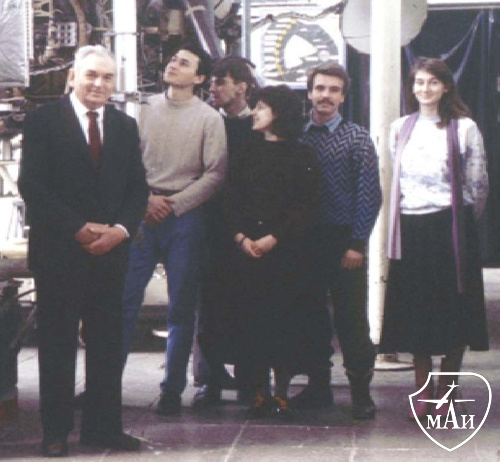 V.P.
Mishin with students in the training hall of the department 601 MAI (1991)
V.P.
Mishin with students in the training hall of the department 601 MAI (1991)
Unique experimental, educational and laboratory base was created and actively introduced into research and development, including: gas-dynamic thermal and thermal vacuum stands with electric arc, radiant and contact heaters for modeling the thermal regimes of descent vehicles; dynamic and acoustic stands for experimental research of aircraft structures; weightlessness tower with a gas gun for studying the behavior of liquids under microacceleration conditions; tower for throwing tests.
Mathematical methods developed at the department and modern means of computer technology and test automation are widely used during the experiments.
Vasily Pavlovich Mishin, with the support of Sergey Pavlovich Korolev, invited to MAI the most highly qualified and competent experts from RSC Energia, including Korolev's deputies and heads of the main design departments of OKB-1. Among them are Sergey Osipovich Okhapkin (deputy for the design of launch vehicles), Anatoly Petrovich Abramov (deputy for launch complexes), Mikhail Vasilievich Melnikov (deputy for propulsion systems), Mikhail Klavdievich Tikhonravov (head of the spacecraft design department), Vladimir Fedorovich Roschin (head department of aerodynamics and heat transfer), Refat Fazylovich Appazov (head of the ballistics department), Vitaly Konstantinovich Bezverby (head of the ballistic design department), Ilya Makarovich Rapoport (a prominent scientist in structural dynamics). Other well-known experts were also involved, in particular, Vladimir Konstantinovich Karrask, one of the creators of the Proton launch vehicle from the Central Design Bureau of Mechanical Engineering (deputy chief designer, director of the Central Design Bureau Vladimir Nikolayevich Chelomey).
Vasily Pavlovich always treated MAI students with respect and affection. He was very upset when he had to put a "2" for the exam.
Mishin was a member of the MAI Academic Council and the Faculty of Aerospace, took active part in the life of the university. Under the leadership of Vasily Pavlovich, MAI carried out extensive scientific research on dynamics, thermal protection, ballistics, machine design and construction.
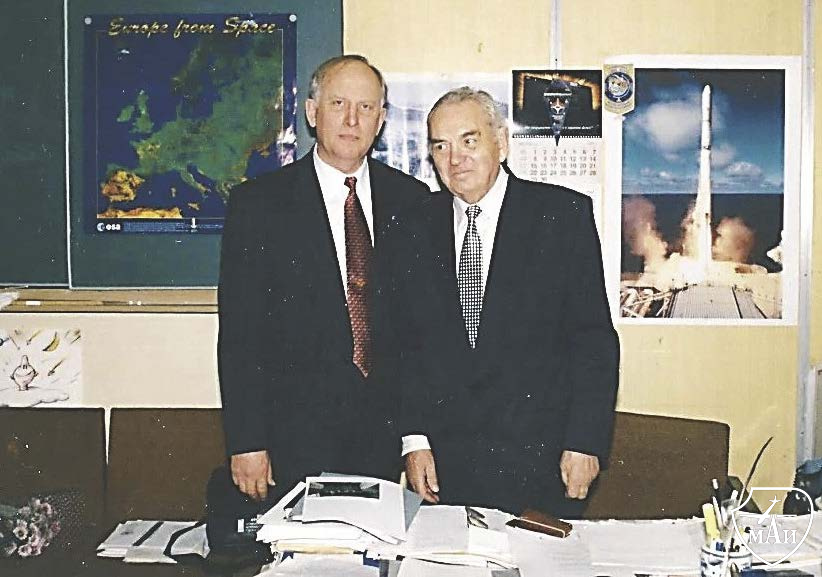 V.P.
Mishin with his student and friend O.M. Alifanov
V.P.
Mishin with his student and friend O.M. Alifanov
The results of the research carried out are being introduced both into the educational process and into the practice of new promising types of aircraft design.
The department created a unique experimental, educational and laboratory base, which is constantly being modernized, modified, but its foundations were laid back under Mishin’s leadership. There are strong research teams. Research and development is being carried out in a number of areas, which were led or in which Vasily Pavlovich himself took part in his time.
One of them is the development of a theory and methodology for designing reusable rocket and space systems. One of the components of these studies is the design development of systems for the rescue and delivery to the base of spent stages and blocks of launch vehicles using aerodynamic force, thrust from ramjet and turbojet aircraft engines. It was the first research and development in this area in the country.
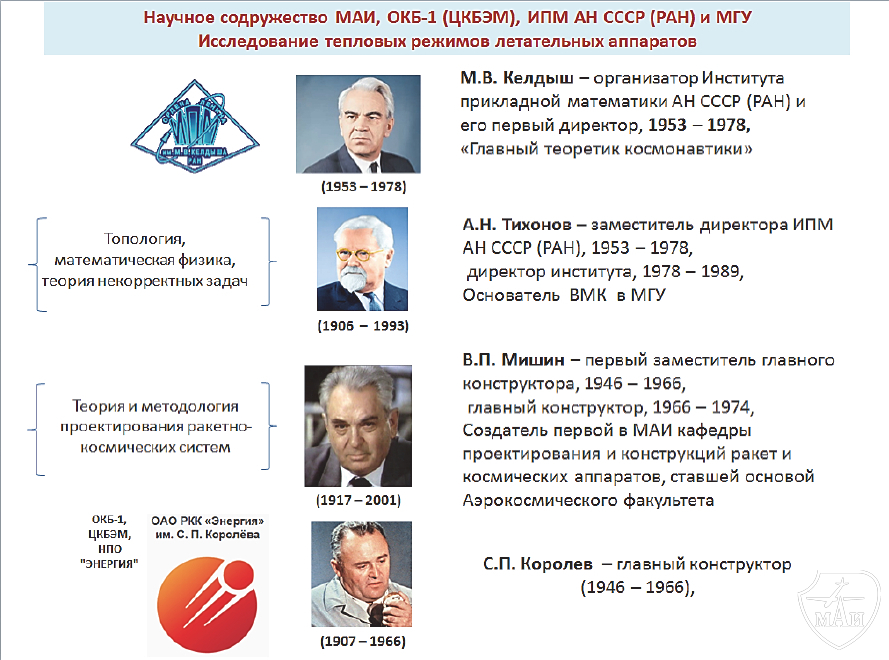 Scientific
community of MAI, OKB-1 (TsKBEM), IPM USSR Academy of Sciences (RAS) and Moscow
State University
Scientific
community of MAI, OKB-1 (TsKBEM), IPM USSR Academy of Sciences (RAS) and Moscow
State University
Vasily Pavlovich was also interested in new trends of fundamental science. One of these areas was associated with the need to solve ill-posed inverse problems and began to develop at the department since the 1970s. In applied terms, it concerned experimental and computational studies of non-stationary operation modes of heat-shielding systems of descent spacecraft and marked the beginning of the development of new mathematical methods for solving unstable heat transfer problems based on the regulation principle formulated by the outstanding mathematician Academician Andrey Nikolaevich Tikhonov. But it was necessary to convince both engineers and scientists working for heat transfer, thermal control, thermal design, and testing that there is potentially a new research paradigm based on the formulations and methods for solving incorrect inverse problems, and that this could give a new quality in engineering research and development.
Andrey Nikolaevich Tikhonov and Vasily Pavlovich Mishin knew each other, moreover, they had a lot in common. Andrey Nikolayevich was deputy for science to Mstislav Vsevolodovich Keldysh, director of the Institute of Applied Mathematics of the USSR Academy of Sciences, and after his death he headed this organization very important for cosmonautics.
Tikhonov created the Faculty of Computational Mathematics and Cybernetics at Moscow State University, and Mishin founded the first Rocket and Space Department at the Moscow Aviation Institute, and then contributed to the creation and development of the Aerospace Faculty. Mishin received his first teaching experience at Moscow State University, where in the 1957/58 academic year, at the invitation of the rector, Academician Ivan Georgievich Petrovsky, he lectured on the design of launch vehicles.
In 1973, the 1st All-Union Scientific and Technical Seminar on Inverse Problems of Heat Conduction and Processing of Thermal Experiment Data was held at MAI under the chairmanship of Academicians Mishin and Tikhonov. Both of them made presentations at the plenary session.
Seminars became regular, and since 1990 they were transferred into the category of international conferences (the world's first international conference on inverse problems was held in Suzdal in September 1990; at present, similar international conferences are held every year in various countries) with the active participation of Americans and Europeans.
These seminars and conferences, which were attended by many mathematicians, physicists, engineers, had and are having a great positive impact on the progress both in the applied theory of inverse problems and in its implementation in various practical research and development. This is really a mutually enriching synergy of theory and practice.
Research methods based on solving inverse problems, developed at the department, already in the 1970-1980s found their practical application in a number of rocket and space projects, and a group of scientists and engineers of the department headed by Vasily Pavlovich Mishin was awarded with the state prize.
Another direction that got its start at the department during the life of Vasily Pavlovich, and then became very popular both in our country and worldwide, is small scientific and educational university satellites. It dates back to the late 1960s, when Mishin organized the Iskra Student Space Design Bureau (SKKB) at the department. The first supervisor of the SKKB was Doctor of Technical Sciences, colleague of Korolev, one of the founders of the GIRD, Honored Worker of Science and Technology of the RSFSR, Hero of Socialist Labor, professor of the department Mikhail Klavdievich Tikhonravov.
Between 1970 and 1974, the SKKB created a series of the country's first unpressurized satellites, which anticipated the development of this technology for space vehicles. In 1978, for the first time in the world, a student (university) communication small-sized satellite Radio-2 was launched into space, which successfully worked for many months, and in 1982, for the first time, from one spacecraft (on board the Salyut-7 orbital station) were launched other spacecraft (connected small-sized satellites "Iskra-2" and "Iskra-3", scientific supervisor – Professor Evgeny Fedorovich Kamenkov). This was followed by launches of scientific small spacecraft for geodetic research "MAK-1" and "MAK-2" (supervisor – Professor Gennady Viktorovich Malyshev). This direction in the activity of the “Mishinskaya” department continues to develop actively at the present time. In 2017, the 3U Iskra-MAI-85 nanosatellite was launched.
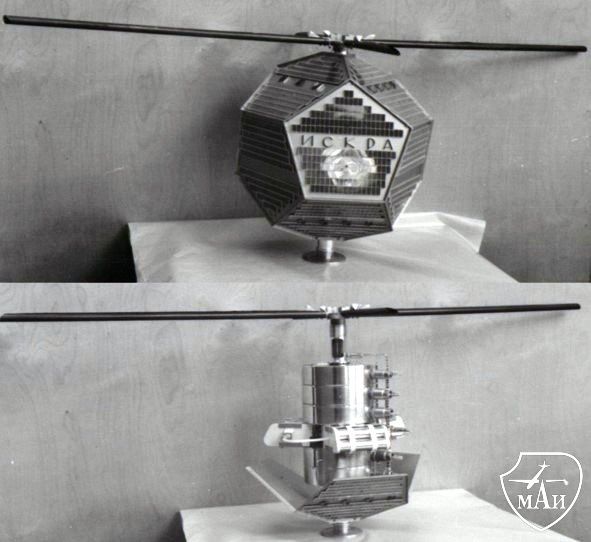 The first student satellites developed at SKKB MAI (1968–1974)
The first student satellites developed at SKKB MAI (1968–1974)
Finally, a few words about one of Mishin's latest lifetime developments. It began with his reports at MAI, RAS and TsAGI. Even in the 1990s, the academician remained true to himself, he was the generator of innovative ideas. He proposed to introduce rocket technology achievements into aviation. Vertical takeoff and vertical landing.
To prove his idea, he invited aircraft, rocket and engine engineers. They showed that such an unexpected approach is not only possible, but can also lead to the creation of more efficient and cheaper aircraft. It was, so to say, the swan song of Vasily Pavlovich.
At the department created by Mishin, thousands of young experts were educated, 26 doctoral and more than 100 master's theses were defended, large modern scientific and pedagogical schools, unique scientific and educational laboratories were created, 27 textbooks and 56 monographs were published.
Vasily Pavlovich himself is the author of hundreds of scientific papers, monographs, textbooks and teaching aids. First of all, here it is necessary to say about the monograph "Ballistics of long-range guided missiles". It went through two editions (the first secret in 1956) and for a couple of decades was the only monograph on this subject in the country. Under the authorship and editorship of Mishin in 1985, a textbook for universities "Fundamentals of aircraft design (transport systems)" was published. This is also a reference book for more than one generation of students and experts in rocket and space technology.
Thus, the affairs of Academician Mishin, including in engineering aerospace education and the training of experts for rocket and space enterprises, conducting research and development work, continue their active life. Cooperation with industry enterprises and universities of the country is being strengthened, international cooperation with organizations and universities of the world is developing.
It must be added that Vasily Pavlovich always actively participated in social and social-scientific activities, in particular, as a deputy of two convocations of the Supreme Council of the Russian Federation. While working at Moscow Aviation Institute, he made a great contribution to the preparation of materials on the scientific heritage of Friedrich Arturovich Zander and to the book about the path of Sergey Pavlovich Korolev, was the chairman of the Academic Council of the Polytechnic Museum, worked at the Academy of Sciences, the Expert Council on Aviation and Rocket and Space Technology of the Higher Certification Commission of the USSR, editorial boards of a number of magazines of the “Znanie” (Knowledge) society etc. At the same time, he constantly defended the outstanding role of Korolev in rocket and space technology, the historical truth about Russian cosmonautics in numerous articles, interviews and reports at domestic and international conferences.
Another touch in order to understan the scale of Mishin's personality: Vasily Pavlovich was always ready to help during difficult times, support his colleagues, share his knowledge and experience with them, so he always had real friends.
Let us give just one, but a very interesting example: one of the main scientists and experts in Chinese rocket and space technology, Academician Wang Yongzhi, the chief designer of the Long March-2F rocket and the general designer of China's manned program, the Shenzhou and Tiangong-2 ships, considers himself to be Mishin’s student.
Wang Yongzhi graduated from Moscow Aviation Institute in 1961 and did a graduation project under the guidance of Vasily Pavlovich, then met with him several times, invited him to lecture at the 1st and 5th Academies of China.
Due to reasons connected with his health, he was not able to come to MAI in 2017 for a conference dedicated to the memory of Vasily Pavlovich, his centenary, but he sent a very cordial, sincere letter and presentation, which, on behalf of Wang Yongzhi, were presented by an employee of the Chinese Embassy.
Here is the last part of that letter:
“I will not forget the kindness of the teacher, I will forever miss my deeply respected teacher Vasily Pavlovich.
Academician Vasily Mishin is a world-famous expert in cosmonautics and rocket science, he has great authority in the world space community. When the presenter at the conference on cosmonautics, which was held in Washington in 1991, said that Academician Mishin was present in the hall, all those who were present stood up and expressed their high respect to him with warm applause. I, as the person sitting next to him, was very shocked. His deep knowledge, rich engineering experience, attentive and conscientious attitude and selfless desire to transfer his knowledge have invaluably enriched the science. He deserves such recognition, I resort to his lessons throughout my life.
I carefully keep a picture of me and Vasily Pavlovich, taken when we met in Beijing after 30 years of separation. This photo always appears in my biography as a color illustration. The perspicacious wisdom in his eyes, the responsiveness on his face, the pioneering contribution made by him to the development of astronautics, humanity, and the efforts spent on educating scientists for the space industry in China and the world are forever alive in my memory.
I miss you forever, dear teacher, Vasily Pavlovich!”
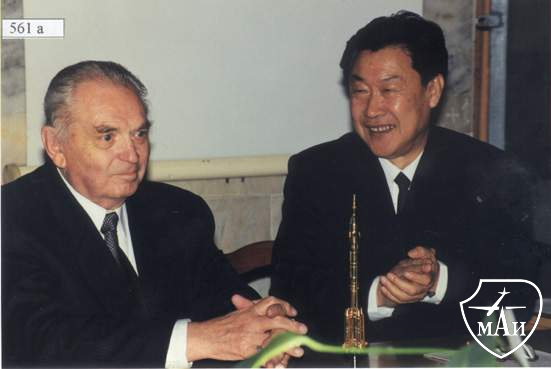 Outstanding
designers of rocket and space technology, academicians V.P. Mishin and Wang
Yongzhi
Outstanding
designers of rocket and space technology, academicians V.P. Mishin and Wang
Yongzhi
For outstanding achievements in astronautics, Vasily Pavlovich was immediately elected a full member of the International Academy of Astronautics, bypassing the stage of election to corresponding members. Such a violation of the charter of this respected academy is exceptional.
Vasily Pavlovich Mishin had a bright original personality. He was a match for a man of such a scale, intellect and character as Sergey Pavlovich Korolev. His life principle was to always look far ahead and bring the future closer with his ideas, research and development.
In technology, he was never content with small, private, he was always interested in new large-scale projects, and he was their initiator and developer. His life was filled to the limit with creativity, deeds and achievements, and these achievements clearly correspond to the main milestones of the development of rocket and space technology in our country.
He had a strong-willed character, consistent and principled in defending the decision he outlined. Fearlessness and uncompromisingness in expressing his opinion on the burning issues of rocket and space technology, defending this opinion with the necessary arguments, was by no means always to the taste of leaders of various ranks.
If in professional affairs Mishin was always energetic, purposeful, decisive, and sometimes even too harsh towards his opponents, in everyday life he often turned out to be unprotected and trusting. Some used it for their own, not always noble, purposes. Getting into such everyday stories, Vasily Pavlovich did not harm anyone in response, did not hold a grudge, and usually spoke about his mistakes with a smile.
We, his colleagues at the department, never ceased to be surprised by his modesty, on the one hand, and the objectivity of his assessments, on the other. He hated arrogance, boasting and politicking. He did not embellish anything, did not exalt his role and spoke only about those cases and events in which he personally and directly participated, he never liked to retell from the words of others. It was his credo not to add anything to what he knew definitely. Such a position is far from always popular, but he considered it to be the only honest one.
Vasily Pavlovich did not share pounds-shillings-and-pence point of view, he was generous and, having great authority, helped them in various everyday and official matters, generously shared his knowledge and rich experience with colleagues and students. At the same time, he himself never stopped learning, read a lot of specialized literature, delved into new scientific directions, having an amazing ability to “grasp everything on the fly”. On his desktop lay not only purely professional literature, but also books, for example, in higher mathematics.
Despite the most severe, debilitating illness, until the very last day, Mishin worked in the hospital on his new project – another touch that is very important for the understanding of his personality.
Vasily Pavlovich loved life. He loved his near and dear, his friends, he was always the soul of the company. With all his merits, he remained an amazingly modest, sincere, deeply decent person, whose word did not disagree with his deed.
He was equally simple and frank and could communicate with a person of any official level – from a worker to a minister, he was uncompromising when it came to the work of his life – to aviation and rocket and space technology.
Vasily Pavlovich Mishin was working for many years at OKB-1 (TsKBEM) and kept daily records of his activities in classified notebooks. There he wrote down what was to be done and how, with whom to meet, issues to discuss, etc. As the result we now have an amazing archive that is reflecting the history of the development of rocket and space technology in the Soviet Union. After the classification was removed, these notes were published as a book titled "Diaries".